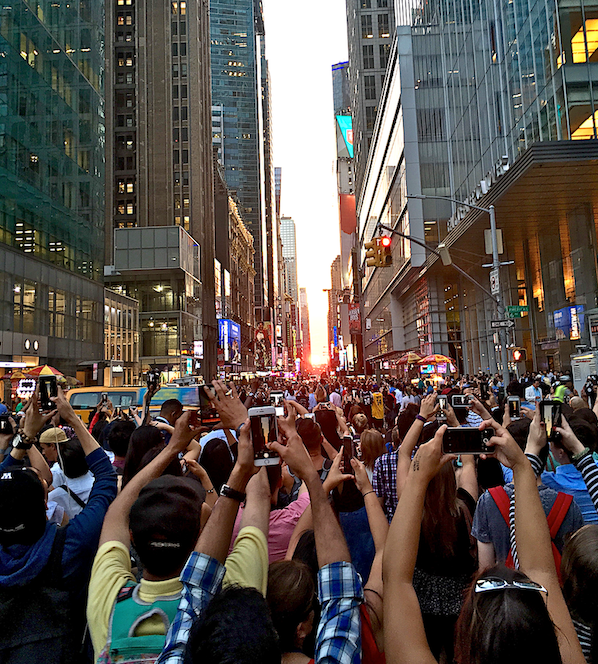BY ANASTASIA KALIABAKOS | Anticipation of a beautiful event has taken social media by storm. Manhattanhenge is a captivating phenomenon that occurs twice a year in New York City in Manhattan. Inspired by the famous Stonehenge in England, it refers to the alignment of the setting sun with the east-west streets of the borough’s street grid, creating a breathtaking spectacle of light and shadows.
The term “Manhattanhenge” was coined by famed astrophysicist Neil deGrasse Tyson, the director of the Hayden Planetarium at the American Museum of Natural History. He noticed the phenomenon’s resemblance to Stonehenge. Stonehenge is one of the most iconic and mysterious archaeological sites in the world, captivating visitors with its enigmatic presence throughout history. Comprised of a circle of massive standing stones, Stonehenge continues to intrigue, raising countless questions about its purpose and the civilization that constructed it.
Believed to have been built between 3000 and 2000 BCE, Stonehenge is a remarkable feat of engineering considering the time when it was constructed. The monument consists of two primary stone types: the “sarsens,” which are large sandstone blocks weighing up to 25 tons, and the smaller “bluestones,” which were transported from southwest Wales, around 150 miles away. The stones were meticulously arranged in various configurations, forming concentric circles and horseshoe shapes.
The purpose of Stonehenge remains shrouded in mystery since no written records from the builders exist. However, numerous theories about it have been proposed over the years. One prevailing hypothesis suggests Stonehenge served as an astronomical observatory and aligned with significant celestial events, such as the summer and winter solstices. The alignment of certain stones with specific astronomical phenomena supports this theory.
Fast-forward to Manhattanhenge. Tyson realized that Manhattan’s well-planned street grid, which runs east-west (though not true east and true west) with broad avenues intersecting it at right angles, creates a similar effect in terms of certain celestial events. A few times a year, the opportunity for the setting and rising sun to align perfectly with the city streets comes about, casting an awe-inspiring glow across the urban landscape of Manhattan.
The event takes place twice a year, near the summer solstice in late May and again in mid-July, when the setting sun aligns precisely with the streets of Manhattan. On these evenings, if the weather cooperates, spectators gather along the major cross streets, such as 14th, 23rd, 34th and 42nd, to witness the sun setting directly between the skyscrapers, creating a mesmerizing corridor of light.
The sight of Manhattanhenge is truly remarkable. As the sun approaches the horizon, it bathes the city’s towering buildings in a warm golden light, casting long shadows down the streets. The phenomenon is especially moving on clear evenings when the vibrant colors of the sky add to the already stunning urban backdrop. Photographers and everyday onlookers eagerly wait for the perfect moment to capture this spectacular display on camera and video.
To experience Manhattanhenge in all its glory, it is crucial to find an unobstructed view of the western horizon. Many New Yorkers and visitors position themselves on the eastern side of the cross streets, patiently waiting for the sun to align with the city grid. As the sun sinks lower, anticipation builds, and the atmosphere becomes charged with excitement. When the moment arrives, a hush falls over the crowd as they witness the glowing orb of the sun framed perfectly by the towering buildings.
While Manhattanhenge has become an iconic event in New York City, it has also inspired similar events in other cities around the world. It has sparked interest in urban design, astronomy and the intersection of nature and human-made environments. It serves as a reminder of the beauty that can be found in unexpected places and highlights the power of nature’s wonders to captivate and inspire us.
Your next opportunity to witness Manhattanhenge this year is Thurs., July 13. Make sure to bring your camera!
Kaliabakos is a graduate of The Brearley School and the College of the Holy Cross. She has been featured in NEO Magazine, The National Herald, The Villager and The Village Sun, and has contributed to WestView News since 2018. She will continue her passion for journalism this year as a Collegiate Network Editorial Fellow in Washington, D.C.


Be First to Comment